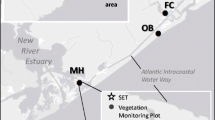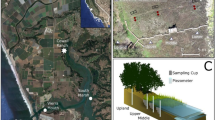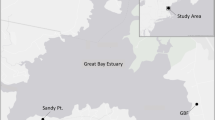Abstract
Along the mid- and north Atlantic coasts of the USA, over 90 % of salt marshes have been ditched. Ditching was largely abandoned by the mid-twentieth century; however, techniques that create permanent shallow water pools for mosquito control and bird habitat are increasingly being applied to marshes of the USA and elsewhere. Salt marshes in Plum Island Sound, Massachusetts, and Barnegat Bay, New Jersey, were used to examine differences between areas that have been ditched and those altered to increase the density of shallow pools in water table dynamics, salinity, soil and porewater chemistry, as well as short-term sedimentation, accretion, and elevation change rates. We found that the area with plugged ditches, berms, and pools in Plum Island had less drainage, higher salinity and porewater sulfide and ammonium concentrations, and higher soil organic matter than the adjacent ditched area. Despite averaging 8 cm lower in elevation, the Plum Island ditched area had less sediment deposition and was composed of higher elevation plant species than the area with plugged ditches, berms, and shallow pools. Elevation increased in the ditched area at a rate of 3.2 ± 0.5 mm/year, but elevation change was variable in the area with pools. In Barnegat Bay, the marsh area with pools and ditches had less sediment deposition and surface accretion than the ditch-only area, associated, in part, with the higher elevation. An average elevation difference of 4.5 cm was associated with a sixfold difference in mineral sediment deposition. Temporal sediment deposition and surface accretion was important in the ditch-only area but was absent or muted in the area with numerous pools. Elevation increased in both marsh areas at an average rate of 1.8 ± 0.8 mm/year, less than half the long-term average local rate of sea-level rise. Our results illustrate how physical manipulations including changes to tidal hydrology and surface topography interact with elevation to influence short-term biophysical feedbacks.







Similar content being viewed by others
References
Adamowicz S.C., and C.T. Roman. 2005. New England salt marsh pools: a quantitative analysis of geomorphic and geographic features. Wetlands 25: 279–288.
Anisfeld S.C., M.J. Tobin, and G. Benoit. 1999. Sedimentation rates in flow-restricted and restored salt marshes in Long Island Sound. Estuaries 22: 231–244.
Bart D., D. Burdick, R. Chambers, and J.M. Hartman. 2006. Human facilitation of Phragmites australis invasions in tidal marshes: a review and synthesis. Wetlands Ecology and Management 14: 53–65.
Baumann R., J. Day, and C. Miller. 1984. Mississippi deltaic wetland survival: sedimentation versus coastal submergence. Science 224: 1093–1095.
Boumans R.M., and J.W. Day Jr. 1994. Effects of two Louisiana marsh management plans on water and materials flush and short-term sedimentation. Wetlands 14: 247–261.
Bourne W.S., and C. Cottam. 1950. Some biological effects of ditching tidewater marshes. U.S. Department of the Interior: 30pFish and Wildlife Service.
Bryant J.C., and R.H. Chabreck. 1998. Effects of impoundment on vertical accretion of coastal marsh. Estuaries 21: 416–422.
Cahoon D.R. 1994. Recent accretion in two managed marsh impoundments in coastal Louisiana. Ecological Applications 4: 166–167.
Cahoon D.R., and D.J. Reed. 1995. Relationships among marsh surface topography, hydroperiod, and soil accretion in a deteriorating Louisiana salt marsh. Journal of Coastal Research 11: 357–369.
Cahoon D.R., and R.E. Turner. 1989. Accretion and canal impacts in a rapidly subsiding wetland II. Feldspar marker horizon technique. Estuaries 12: 260–268.
Cahoon D.R., J.C. Lynch, and R.M. Knaus. 1996. Improved cryogenic coring device for sampling wetland soils. Journal of Sedimentary Research 66: 1025–1027.
Cahoon D.R., J.C. Lynch, P. Hensel, R. Boumans, B. Perez, B. Segura, and J.W. Day. 2002a. High-precision measurements of wetland sediment elevation: I. Recent improvements to the Sediment-Erosion Table. Journal of Sedimentary Research 72: 730–733.
Cahoon, D.R., J.C. Lynch, B.C. Perez, B. Segura, R. Holland, C. Stelly, G. Stephenson, and P. Hensel. 2002b. A device for high precision measurement of wetland sediment elevation: II. The rod surface elevation table. Journal of Sedimentary Research 72: 734–739.
Cavatorta J.R., M. Johnston, C. Hopkinson, and V. Valentine. 2003. Patterns of sedimentation in a salt marsh dominated estuary. Biological Bulletin 205: 239–241.
Christiansen T., P.L. Wiberg, and T.G. Milligan. 2000. Flow and sediment transport on a tidal salt marsh surface. Estuarine, Coastal and Shelf Science 50: 315–331.
Clarke J., B.A. Harrington, T. Hruby, and F.E. Wasserman. 1984. The effect of ditching for mosquito control on salt marsh use by birds in Rowley, Massachusetts. Journal of Field Ornithology 55: 160–180.
Cline J.D. 1969. Spectrophotometric determination of hydrogen sulfide in natural waters. Limnology and Oceanography 14: 454–458.
Corman S.S., C.T. Roman, J.W. King, and P.G. Appleby. 2012. Salt marsh mosquito-control ditches: sedimentation, landscape change, and restoration implications. Journal of Coastal Research 28: 874–880.
Crain, C.M., K.B. Gedan, and M. Dionne. 2009. Tidal restrictions and mosquito ditching in New England marshes. In Human impacts on salt marshes: a global perspective, eds, B.R. Silliman, E.D. Grosholz, and M.D. Bertness, 149–169. University of California Press Berkeley, California.
Daiber F.C. 1986. Conservation of tidal marshes. New York: Van Nostrand Reinhold.
DeLaune R.D., W.H. Patrick, and N. Van Breemen. 1990. Processes governing marsh formation in a rapidly subsiding coastal environment. Catena 17: 277–288.
Erwin R.M., J.S. Hatfield, M.A. Howe, and S.S. Klugman. 1994. Waterbird use of saltmarsh ponds created for Open Marsh Water Management. The Journal of Wildlife Management 58: 516–524.
Erwin R.M., G.M. Sanders, and D.J. Prosser. 2004. Changes in lagoonal marsh morphology at selected northeastern Atlantic coast sites of significance to migratory waterbirds. Wetlands 24: 891–903.
Erwin R.M., D.R. Cahoon, D.J. Prosser, G.M. Sanders, and P. Hensel. 2006. Surface elevation dynamics in vegetated Spartina marshes versus unvegetated tidal ponds along the mid-Atlantic Coast, USA, with implications for waterbirds. Estuaries and Coasts 29: 96–106.
Ferrigno F., and D.M. Jobbins. 1968. Open marsh water management. Proceedings of the New Jersey Mosquito Extermination Association 55: 104–115.
Gallagher J.L., and F.G. Plumley. 1979. Underground biomass profiles and productivity in Atlantic coastal marshes. American Journal of Botany 66: 156–161.
Gabet E.J. 1998. Lateral migration and bank erosion in a saltmarsh tidal channel San Francisco, California. Estuaries 21: 745–753.
Hartig E.K., V. Gornitz, A. Kolker, F. Mushacke, and D. Fallon. 2002. Anthropogenic and climate-change impacts on salt marshes of Jamaica Bay, New York City. Wetlands 22: 71–89.
Havill D.C., A. Ingold, and J. Pearson. 1985. Sulfide tolerance in coastal halophytes. Vegetatio 62: 279–285.
Headlee T. 1945. Mosquitoes of New Jersey and their control. New Brunswick: Rutgers University Press.
Howes B.L., and D.D. Goehringer. 1994. Porewater drainage and dissolved organic carbon and nutrient losses through intertidal creekbanks of a New England salt marsh. Marine Ecology Progress Series 114: 289–301.
Hruby T., W.G. Montgomery, R.A. Lent, and N. Dobson. 1985. Open marsh water management in Massachusetts: adapting the technique to local conditions and its impact on mosquito larvae during the first season. Journal of the American Mosquito Control Association 1: 85–88.
James-Pirri, M.J., R.M. Erwin, and D.J. Presser. 2008. US Fish and Wildlife Service (Region 5) Salt Marsh Study, 2001–2006: an assessment of hydrologic alterations on salt marsh ecosystems along the Atlantic coast. USGS Patuxent Wildlife Research Center and University Rhode Island, Final Report to U.S. Fish and Wildlife Service, April 2008. (ftp://ftpext.usgs.gov/pub/er/md/laurel/OMWM/Region5_salt_marsh_FINAL_REPORT_April12_2008.pdf).
James-Pirri M.J., H.S. Ginsberg, R.M. Erwin, and J. Taylor. 2009. Effects of Open Marsh Water Management on numbers of larval salt marsh mosquitoes. Journal of Medical Entomology 46: 1392–1399.
James-Pirri M.J., R.M. Erwin, D.J. Prosser, and J.D. Taylor. 2012. Responses of salt marsh ecosystems to mosquito control management practices along the Atlantic Coast (U.S.A). Restoration Ecology 20: 395–404.
Kennish M.J. 2001. Physical description of the Barnegat Bay-Little Egg Harbor estuarine system. Journal of Coastal Research 32: 13–27.
Kirby R.E., and L.E. Widjeskog. 2013. Sediment redistributed by coastal marsh mosquito ditching in Cape May, New Jersey, U.S.A. Journal of Coastal Research 29: 86–93.
Koch M.S., and I.A. Mendelssohn. 1989. Sulphide as a soil phytotoxin: differential responses in two marsh species. Journal of Ecology 77: 565–578.
Lagomasino D., D.R. Corbett, and J.P. Walsh. 2013. Influence of wind-driven inundation and coastal geomorphology on sedimentation in two microtidal marshes, Pamlico River Estuary, NC. Estuaries and Coasts 36: 1165–1180.
Lathrop R.G., M.B. Cole, and R.D. Showalter. 2000. Quantifying the habitat structure and spatial pattern on New Jersey (U.S.A.) salt marshes under different management regimes. Wetlands Ecology and Management 8: 163–172.
Lathrop R.G. Jr., and J.A. Bognar. 2001. Habitat loss and alteration in the Barnegat Bay region. Journal of Coastal Research 32: 212–228.
Leonard L.A., and M.E. Luther. 1995. Flow hydrodynamics in tidal marsh canopies. Limnology and Oceanography 40: 1474–1484.
Meredith W.H., D.E. Saveikis, and C.J. Stachecki. 1985. Guidelines for "Open Marsh Water Management" in Delaware’s salt marshes—objectives, system designs, and installation procedures. Wetlands 5: 119–133.
Meredith W.H., and C.R. Lesser. 2007. An overview of Open Marsh Water Management (OMWM) in Delaware, 1979–2007. Proceedings of the NJ Mosquito Control Association 94: 55–69.
Miller W.R., and F.E. Egler. 1950. Vegetation of the Wequetequock-Pawcatuck tidal-marshes, Connecticut. Ecological Monographs 20: 143–172.
Montalto F.A., T.S. Steenhuis, and J.Y. Parlange. 2006. The hydrology of Piermont Marsh, a reference for tidal marsh restoration in the NY Estuary. Journal of Hydrology 316: 108–128.
Montalto F.A., J.Y. Parlange, and T.S. Steenhuis. 2007. A simple model for predicting water table fluctuations in a tidal marsh. Water Resources Research 43. doi:10.1029/2004WR003912.
Mora J.W., and D.M. Burdick. 2013. The impact of man-made earthen barriers on the physical structure of New England tidal marshes (USA). Wetlands Ecology and Management 21: 387–398.
Morris J.T., P.V. Sundareshwar, C.T. Nietch, B. Kjerfve, and D.R. Cahoon. 2002. Responses of coastal wetlands to rising sea level. Ecology 83: 2869–2877.
NCDC, NOAA. http://www.ncdc.noaa.gov/
NOAA 2012. http://tidesandcurrents.noaa.gov/sltrends/
Nepf H.M. 1999. Drag, turbulence, and diffusion in flow through emergent vegetation. Water Resources Research 35: 479–489.
Nuttle W.K., and H.F. Hemand. 1988. Salt marsh hydrology: implications for biogeochemical fluxes to the atmosphere and estuaries. Global Biogeochemical Cycles 2: 91–114.
Nyman J.A., and R.D. DeLaune. 1991. CO2 emission and soil Eh responses to different hydrological conditions in fresh, brackish, and saline marsh soils. Limnology and Oceanography 36: 1406–1414.
Nyman J.A., R.D. DeLaune, H.H. Roberts, and W.H. Patrick. 1993. Relationship between vegetation and soil formation in a rapidly submerging coastal marsh. Marine Ecology Progress Series 96: 269–279.
Paquette, C.H., K.L. Sundberg, R.M.J. Boumans, and G.L. Chmura. 2004. Changes in salt marsh surface elevation due to variability in evapotranspiration and tidal flooding. Estuaries 27: 82–89.
Pearson J., and D.C. Havill. 1988. The effect of hypoxia and sulfide on culture grown wetland and non-wetland plants. 2. Metabolic and physiological changes. Journal of Experimental Botany 39: 431–439.
Portnoy J.W. 1999. Salt marsh diking and restoration: biogeochemical implications of altered wetland hydrology. Environmental Management 24: 111–120.
Portnoy J.W., and A.E. Giblin. 1997. Effects of historic tidal restrictions on salt marsh sediment chemistry. Biogeochemistry 36: 275–303.
Redfield A.C. 1972. Development of a New England salt marsh. Ecological Monographs 42: 201–237. doi:10.2307/1942263.
Reddy K.R., and W.H. Patrick Jr. 1975. Effect of alternate aerobic and anaerobic conditions on redox potential, organic matter decomposition, and nitrogen loss in a flooded soil. Soil Biology and Biochemistry 7: 87–94.
Roman C.T., W.A. Niering, and R.S. Warren. 1984. Salt marsh vegetation change in response to tidal restriction. Environmental Management 8: 141–150.
Schubauer J.P., and C.S. Hopkinson. 1984. Above- and belowground emergent macrophyte production and turnover in a coastal marsh ecosystem, Georgia. Limnology and Oceanography 29: 1052–1065.
Stoddart D.R., D.J. Reed, and J.R. French. 1989. Understanding salt-marsh accretion, Scolt Head Island, Norfolk, England. Estuaries 12: 228–236.
Stumpf R.P. 1983. The process of sedimentation on the surface of a salt marsh. Estuarine, Coastal and Shelf Science 17: 495–508.
Temmerman S., G. Govers, S. Wartel, and P. Meire. 2003. Spatial and temporal factors controlling short-term sedimentation in a salt and freshwater tidal marsh, Scheldt estuary, Belgium, SW Netherlands. Earth Surface Processes and Landforms 28: 739–755.
Temmerman, S., P. Moonen, J. Schoelynck, G. GOvers, and T.J. Bouma. 2012. Impact of vegetation die-off on spatial flow patterns over a tidal marsh. 39: L03406, doi:10.1029/2011GL050502.
Tonjes D.J. 2013. Impacts from ditching salt marshes in the mid-Atlantic and northeastern United States. Environmental Reviews 21: 116–126. doi:10.1139/er-2013-0003.
US EPA, 1984. Methods for chemical analysis of water and wastes, March 1984, EPA-600/4-79-020. "Nitrogen, Ammonia", method 350.1 (colorimetric, automated phenate).
US EPA. 1992. Determination of carbon and nitrogen in sediments and particulates of estuarine/coastal waters using elemental analysis. Method 440.0 In: Methods for the determination of chemical substances in marine and estuarine environmental samples. EPA/600/R-92/121 ORD, Washington DC.
US EPA. 1997. Determination of ammonia in estuaries and coastal water by gas segmented continuous flow colorimetric analysis. Method 349.0. National Exposure Research Laboratory, ORD, US EPA, Cincinnati, OH
Vincent R.E., D.M. Burdick, and M. Dionne. 2013. Ditching and ditch-plugging in new England salt marshes: effects on hydrology, elevation, and soil characteristics. Estuaries and Coasts 36: 610–625. doi:10.1007/s12237-012-9583-y.
Vörösmarty C., and T. Loder. 1994. Spring-neap tidal contrasts and nutrient dynamics in a marsh-dominated estuary. Estuaries 17: 537–551.
Whigham, D.F., J.P. O’Neill, and M. McWethy. 1982. Ecological implications of manipulating coastal wetlands for purposes of mosquito control. pp. 459–479. Gopal, B. (ed) Wetlands: Ecology and Management. Jaipur, India: National Institute of Ecology and International Scientific Publications.
Wood M.E., J.T. Kelley, and D.F. Belknap. 1989. Patterns of sediment accumulation in the tidal marshes of Maine. Estuaries 12: 237–246.
Yelverton, G.F. and C.T. Hackney. 1986. Flux of dissolved organic carbon and pore water through the substrate of a Spartina alterniflora marsh in North Carolina. Estuarine Coastal and Shelf Science 22: 255–267.
Zedler J.B., T. Winfield, and P. Williams. 1980. Salt marsh productivity with natural and altered tidal circulation. Oecologia 44: 236–240.
Acknowledgments
This research was funded by the US Fish and Wildlife Service through the Cooperative Ecosystem Studies Unit. The findings and conclusions in this article are those of the author(s) and do not necessarily represent the views of the US Fish and Wildlife Service (USFWS). We would like to thank D. Cahoon and J. Lynch who provided advice, insight, and assistance on the experimental design for surface elevation tables and marker horizons. V. Turner at Edwin B. Forsythe National Wildlife Refuge (NWR), NJ, and S. Janson at Parker River NWR, MA, collected long-term SET data. Y. Laskaris of USFWS Region 5 Salt Marsh LMRD program compiled and helped analyzed the long-term SET data. Refuge managers, V. Rettig at Forsythe and N. Pau at Parker River, provided help and cooperation. We would like to thank M. Brannin who provided expertise in surveying and GIS, V. Unger, L. Zaoudeh, M. Shafer, W. Whalon, A. Tarbous, P. Zelanko, and W.T. Quirk for the field and lab assistance. L. Perez provided time-series GIS analyses of water area. P. Zelanko and P. Kiry conducted chemical analyses. B. Frezel cut PVC wells for probes and helped in the field. W.T. Quirk fabricated sediment plates, boardwalks, and a marsh cart. M. Leck and R. DeLaune graciously edited and improved the paper. Two anonymous reviewers provided helpful commentary and suggestions.
Author information
Authors and Affiliations
Corresponding author
Additional information
Communicated by Charles Simenstad
Electronic Supplementary Material
ESM 1
(DOCX 17 kb)
Rights and permissions
About this article
Cite this article
Elsey-Quirk, T., Adamowicz, S.C. Influence of Physical Manipulations on Short-Term Salt Marsh Morphodynamics: Examples from the North and Mid-Atlantic Coast, USA. Estuaries and Coasts 39, 423–439 (2016). https://doi.org/10.1007/s12237-015-0013-9
Received:
Revised:
Accepted:
Published:
Issue Date:
DOI: https://doi.org/10.1007/s12237-015-0013-9




